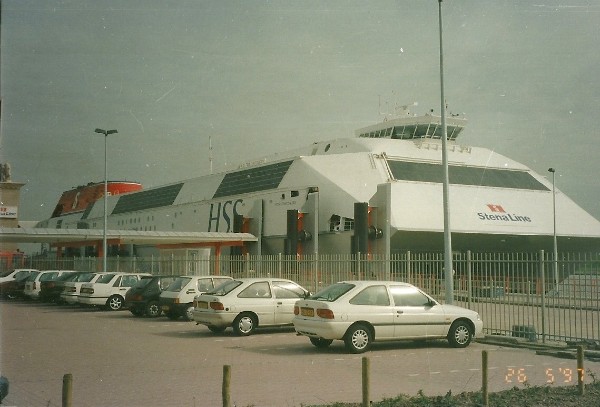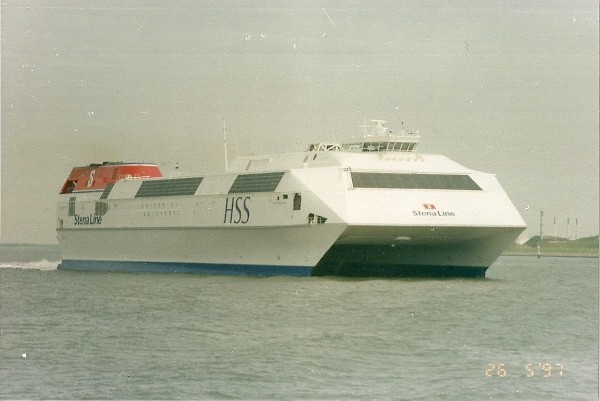Stena Discovery
In the 1990's, Stena Line introduced a new kind of sea travel. The HSS concept, High-speed Sea Service, was to be a novelty for the company. A series of two smaller and three bigger ships would be built, the three larger ships would operate routes around the British Isles and the two smaller ones would be stationed in Scandinavia. These ships would be capable of a speed up to 40 knots, thats 75 km per hour. Because of their speed, these ships were able to replace two ships and still perform the normal amount of sailings on a route. This, of course would be a huge cost-saver.
The first of the smaller ships, under the HSS 900 name, the 900 being the passenger-capacity, was to be delivered in 1996 to Stena Line. Problems occured, the wharf, Westamarine AS at Kristiansand in Norway, was declared bankrupt while the pair was built. The first ship was eventually finished and put into service one year behind scedule under the name of Stena Carisma, on the Göteborg to Frederikshavn service. The second one of the pair, although 30%complete, was scrapped so only one of these ships entered service. Not without its problems, though, because just after the ship was delivered, a big problem with corrosion was discovered at the weldings. Because of the bankrupcy of the wharf, and the fact that this was not covered in Stena Line's all-risk guarantee, this proved to be a costly problem.
The first ship of the HSS 1500 class was the Stena Explorer, built at the Aker Finnyards at Rauma, Finland. This ship entered service at the route between Dun Laoghaire in Ireland and Holyhead in Wales. She was named in Dun Laoghaire at the 14th of september 1996, although she already started her sailings at the 10th of april of that year. The second ship of the class was the Stena Voyager, sailing the Stanraer (Scotland) to Belfast (Northern Ireland) route from the 21st of july 1996 onwards.

Stena Discovery entering Hoek van Holland at the 12th of february 2004.
The Stena Discovery was the thirth and last of the HSS class to be built by Stena Line. The ship was, like her sisters, built in Rauma under her yardnumber 407. The ship has a tonnage of 19.638 and this tonnage maked these ships the biggest twin-hulled ferries in the world. The Stena Discovery has a lenght of 121,75 meters, a width of 40 meters and she is powered by four Kvaerner-built gasturbines. The ships has accomodations for 1520 daypassengers, so she has no cabins and only one passengerdeck. On the passengerdeck, a movie theater, lounges, a sportsbar, a McDonalds and an a-la-carte restaurant are among the features. At the front end of the ship is a large panoramic window, that gives the passengers a great view forward. Two cardecks are below the passengerdeck and some 775 meters are available here, with room for about 375 cars. The cars enter through the ships backdoors at one side of the ship, then park at the cardeck in a 'U'-shape. This way, disembarking can be done very fast, when the doors at the other side (left or right) are opened and they can drive off.

Stena Discovery at her new Hoek van Holland berth at the 26th of may 1997, just after her first arrival to her new home port. This day, a small series of seatrials was also carried out.
On the 14th of december 1996, the ship was sailing out her building dock and delivered to Stena Line on the 21st of april 1997. Her first sailings were at the route between Stanraer and Belfast between the 26th of april and the 24th of may 1997 to cover for Stena Voyager. But the ship was intended for the route between Hoek van Holland and Harwich, to replace the two older conventional overnight-ferries Stena Europe and Koningin Beatrix. Huge changes had to be made to the docking facillities at both ports, at a cost of around 300 million pounds, the same price as for the ship itself. The ship was named at Hoek van Holland by the Dutch secretary of Traffic and Waterways, Annemarie Jorritsma, at the 28th of june 1997, two days after succesfull seatrials at Hoek van Holland. Her first sailing at the route started from Hoek van Holland at the 2nd of june 1997. The new ship was a true big thing in Holland, her publicity campaign has been enormous. But the first cracks in the smooth new service were literary there when the ship hit a 3,5 meter high swell when travelling at full speed at the 4th of january 1998. The water was pushed up the nose of the ship and even reached the bridge windows. This, of course was not a real problem, that was the fact that the HSS was not designed to deal with this situation and the swell had ripped through the underside of the nose, damaging it extensively. A lawsuit was issued to the company and the captain, who was said to be ignoring storm warnings, still setting sail although the ship was better to be in port. Later, the captain was freed from charges. Stena Voyager temporarely replaced Stena Discovery while the ship was being repaired. Problems were also on shore, after the ferry was taken into service, the quaysides at Harwich were washed over heavily due to the waves created by the speeding ship. Because of these 0,5 meter waves created by the ship, she was nicknamed 'The Wave Machine' by the people from Harwich and Felixtowe. Stena Line responded by sailing the ship slowly passed Harwich and started sailing at high speed when the ship had reached open water. Also, signs were added to the quaysides and a warning signal was put into place at the quays so people would know when 'The Wave Machine' was entering port. In Hoek van Holland, inhabitants were complaining about the smell of the ship exhausts so on both sides there was not really a widespread affection for the new ferry. But more bad publicity was on the horizon. On the 23rd of august of the same year 1998, the ship suffered big problems by docking at Hawich when the ship had to dock around 7 in the evening, but passengers could finally be offloaded at 1 o' clock the next morning, and they were sent to hotels in Harwich. The ship could finish docking finally at 2 in the morning. Three sailings were cancelled. In september of that same year, some more sailings had to be cancelled when the ship suffered severe problems with her propulsion system. So the first years of the HSS Northseaservice were not uneventfull.

Stena Discovery, picking up speed for trails at Hoek van Holland at the 26th of may 1997.
At the 15th of march 2001, after a few years of reletively quiet and normal sailings, a driver of an 18-ton lorry forgot to put on the handbrakes of his vehicle while parking in the cardeck of the ship. While the Stena Discovery speeded up on her Hoek van Holland to Harwich sailing, the lorry broke free and slided backwards, crashing through the rear doors of the ferry and plunging down in the Northsea. It took three smaller Ford Transit vans with it, and of course the rear doors. The ship had to return to Hoek van Holland and the total damage to the ship and the loss of the cars was estimated at around 200.000 pounds. Exactly the same kind of incident happened also to Stena Voyager at the 28th of january 2009 when a lorry carrying sulphite powder was crashed through the reardoors of the ship because of forgotten handbrakes. Luckily, the lorry was just dangeling at the back of the ship by return to Stanraer and had not managed to be plunged into the sea.
The cost-saving HSS services were so to speak not very lucky services and very costly too. Next to these incidents, especially on the route between Hoek van Holland and Harwich, passengernumbers were not as good as hoped. The departure and arrival times were, due to the dual scedule the ship sailed very late or early and so not very pleasing to the public. The competition at the Northsea-routes is very fierce and the introduction of low-cost airline flights between Amsterdam, Rotterdam and London did not help either. Apart from the problems to attract passengers, the ship was a fuel-consumer of the first grade and the costs to operate this cost-saving vessel became too high. A solution was found for the arrival and departure times, when two new contemporary ferries were put into service at the route. These ships were put into service mainly for lorrydrivers, freight and passengers travelling with caravans under the names of Stena Hollandica and Stena Britannica. This happened in the winter of 2000/2001. These new ships were very satisfactory for Stena Line, but the idea that they had in mind for the Stena Discovery was blown to smithereens of course. Just two years later, the Stena Britannica was replaced by an even bigger ship with the same name from february 2003 onwards. Three years later, Stena Line announced that the Highspeed Sea Service between Hoek van Holland and Harwich would be discontinued the next year, mainly due to the high fuel consumption of the Stena Discovery, as well as the declining passengernumbers. The vessel that was to be designed as a cost-saver had become too expensive to operate.
The ship was taken out of service at the 8th of january 2007 and she arrived at Belfast, close to the wharf of Harland and Wolff to be laid up at the 24th of january. She had sailed the route via Dover and the Isle of Wight. The ship was returned to the ownership of Stena RoRo and it was stated that she would not be used within Northern European services anymore, because of the patent Stena Line had at her design. So the ship layed idle in the Belfast Lough for two years, before she was finally sold to a new company from Venezuela called Albamar. For this, she was renamed HSS Discovery. The ship was docked in april 2009 to have her fit out for her new role, a service between La Guaira, Estado Vargas and El Guamache, Estado Nuevo Esparta on the Marguerita Island. Her new homeport became Nassau at the Bahamas. Because Venezuela is a oil-producing country, the costs for fuel are much lower then they are in Europe so this makes the route probably economical to run. On the 29th of september 2009, the ship finally left Belfast, arriving in Venezuela at the 26th of october.
The service for Albamar was only short, because the ship was taken out of service again in 2009. In november of 2011, the former Stena Line ferry was moved to Curacao and laid up, awaiting a buyer that would use her for a new service between Curacao and La Guaira. She is still there.

